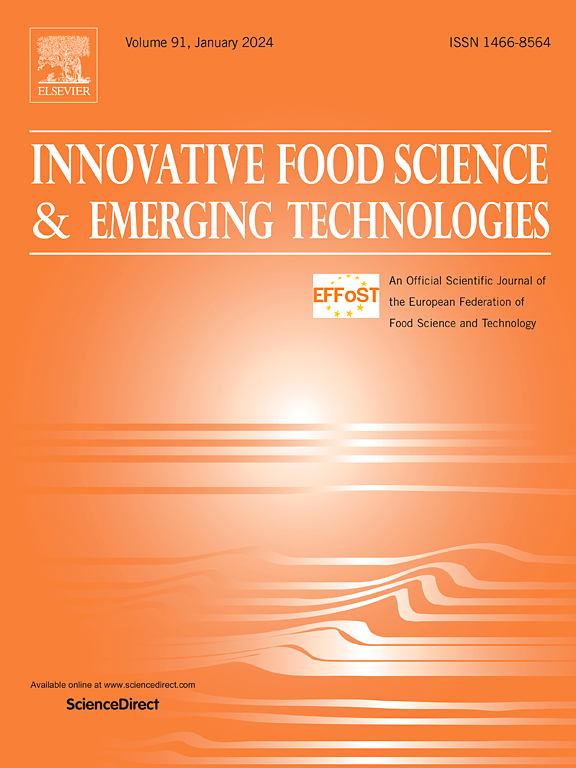A novel strategy of vacuum-packaged chicken feet for bacteriostasis and antioxidation: Pickering emulsion of ZnO / Star anise essential oils combined with radiofrequency treatment
IF 6.3
1区 农林科学
Q1 FOOD SCIENCE & TECHNOLOGY
Innovative Food Science & Emerging Technologies
Pub Date : 2024-12-28
DOI:10.1016/j.ifset.2024.103913
引用次数: 0
Abstract
Vacuum-packed meat products that require a longer shelf-life need high temperatures as secondary sterilization. In order to reduce the quality change and flavor loss caused by autoclaving, ZnO nanoparticles (ZnO NPs) equipped with star anise essential oil (SAEO) were used to make a Pickering emulsion (ZS) to treat cooked tiger skin chicken feet, and then combined with radiofrequency (RF) treatment for pasteurization. The emulsions made from the combination of different concentrations of ZnO NPs and SAEO were evaluated, and a suitable concentration combination (0.03 % (w/w) ZnO NPs, 0.4 % (v/v) oil phase) was selected for the experiment. In the subsequent experiments, the treatment groups of ZS treatment combined with RF treatment for 20 min (ZSRF-20) and 30 min (ZSRF-30) were able to maintain the microbial load of the samples at a low level (reducing the CFUs by about 2 logarithms compared with the control group). Comparing with high pressure steam (HPS), the synergistic treatment group showed less change in appearance and color, and had a better mitigating effect on the degree of lipid oxidation of the samples during the pasteurization process, with CD value and TBARS value of 0.028 mmol/g and 0.065 μg/g with ZSRF-30 treatment. In addition, the sulfhydryl content indicated that the synergistic pasteurization treatment slowed down protein oxidation. Volatiles and flavor were evaluated and the synergistic treatment group was able to reduce the flavor loss of the samples. The findings suggested that the treatment with ZSRF would be a novel approach to preserve the quality of vacuum-packed chicken feet.
Industrial relevance
Pickering emulsion containing ZnO NPs and Star anise essential oil was prepared and combined with radiofrequency heating for co- pasteurize of vacuum-packed tiger chicken feet. RF can cause microbial inactivation, and its mechanisms include thermal and non-thermal effects. Compared with autoclaving, the use of RF for pasteurization better preserves food flavor and reduces variation in quality. Vegetable oil can enhance the wettability of ZnO NPs and enhance their emulsification properties. The emulsion prepared by ZnO NPs and plant essential oil showed antibacterial properties. Combined with radiofrequency heating, flexible pasteurization can be achieved.
真空包装鸡爪抑菌抗氧化的新策略:氧化锌/八角茴香精油皮克林乳液联合射频处理
需要较长保质期的真空包装肉制品需要高温作为二次灭菌。为减少蒸熟虎皮鸡爪的质量变化和风味损失,采用氧化锌纳米颗粒(ZnO NPs)配以八角茴香精油(SAEO)制备酸洗乳剂(Pickering emulsion, ZS)处理熟虎皮鸡爪,并结合射频(RF)处理进行巴氏杀菌。对不同浓度的ZnO NPs和SAEO组合制备的乳液进行了评价,并选择了最合适的浓度组合(0.03% (w/w) ZnO NPs, 0.4% (v/v)油相)进行实验。在随后的实验中,ZS联合RF处理20 min (ZSRF-20)和30 min (ZSRF-30)处理组能够将样品的微生物负荷维持在较低水平(与对照组相比,cfu降低了约2个对数)。与高压蒸汽(HPS)相比,协同处理组样品的外观和颜色变化较小,对巴氏杀菌过程中样品的脂质氧化程度有更好的缓解作用,ZSRF-30处理的CD值和TBARS值分别为0.028 mmol/g和0.065 μg/g。此外,巯基含量表明协同巴氏杀菌处理减缓了蛋白质氧化。对挥发分和风味进行了评价,协同处理组能够减少样品的风味损失。研究结果表明,用ZSRF处理将是一种保持真空包装鸡爪质量的新方法。制备了工业相关的含ZnO NPs和八角茴香精油的浸泡乳剂,并结合射频加热对真空包装虎凤爪进行了共巴氏杀菌。射频可引起微生物失活,其机制包括热效应和非热效应。与高压灭菌相比,使用射频进行巴氏灭菌可以更好地保存食品风味,减少质量变化。植物油可以提高ZnO纳米粒子的润湿性,提高其乳化性能。ZnO NPs与植物精油制备的乳液具有抗菌性能。结合射频加热,可实现灵活的巴氏杀菌。
本文章由计算机程序翻译,如有差异,请以英文原文为准。
求助全文
约1分钟内获得全文
求助全文
来源期刊
CiteScore
12.00
自引率
6.10%
发文量
259
审稿时长
25 days
期刊介绍:
Innovative Food Science and Emerging Technologies (IFSET) aims to provide the highest quality original contributions and few, mainly upon invitation, reviews on and highly innovative developments in food science and emerging food process technologies. The significance of the results either for the science community or for industrial R&D groups must be specified. Papers submitted must be of highest scientific quality and only those advancing current scientific knowledge and understanding or with technical relevance will be considered.

 求助内容:
求助内容: 应助结果提醒方式:
应助结果提醒方式:


